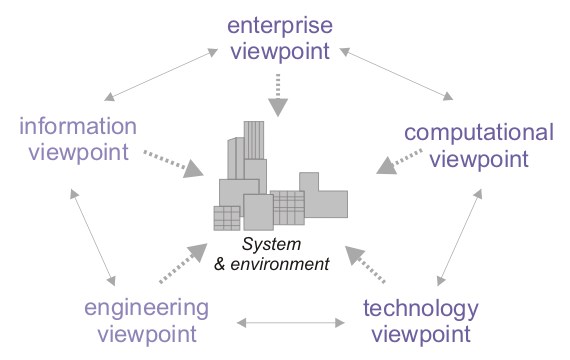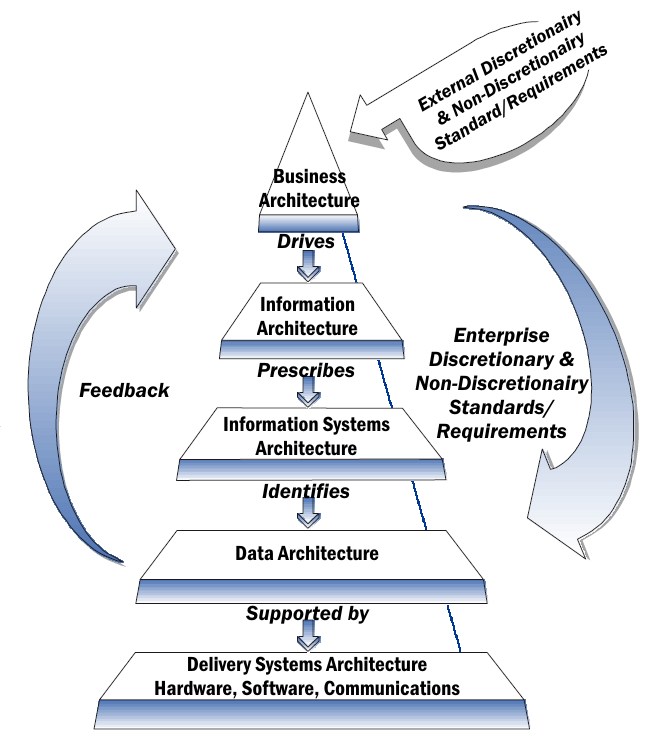|
IEEE 1471
IEEE 1471 is a superseded IEEE standard for describing the architecture of a "software-intensive system", also known as software architecture. In 2011 it was superseded by ISO/IEC/IEEE 42010, ''Systems and software engineering — Architecture description''. Overview IEEE 1471 is the short name for a standard formally known as ANSI/IEEE 1471-2000, ''Recommended Practice for Architecture Description of Software-Intensive Systems.'' Within Institute of Electrical and Electronics Engineers (IEEE) parlance, this is a "recommended practice", the least normative of its standards. In 2007 this standard was adopted by ISO/IEC JTC1/SC7 as ISO/IEC 42010:2007, ''Systems and Software Engineering -- Recommended practice for architectural description of software-intensive systems''. It has long been recognized that "architecture" has a strong influence over the life cycle of a system. However, until relatively recently, hardware issues have tended to dominate architectural thinking, and so ... [...More Info...] [...Related Items...] OR: [Wikipedia] [Google] [Baidu] |
IEEE Standard
The Institute of Electrical and Electronics Engineers Standards Association (IEEE SA) is an operating unit within IEEE that develops global standards in a broad range of industries, including: power and energy, artificial intelligence systems, internet of things, consumer technology and consumer electronics, biomedical and health care, learning technology, information technology and robotics, telecommunication, automotive, transportation, home automation, nanotechnology, information assurance, emerging technologies, and many more. IEEE SA has developed standards for over a century, through a program that offers balance, openness, fair procedures, and consensus. Technical experts from all over the world participate in the development of IEEE standards. IEEE SA provides a neutral platform that unites communities for standards development and technological innovation and is independent of any government oversight. IEEE SA develops standards that are consensus-based and has two t ... [...More Info...] [...Related Items...] OR: [Wikipedia] [Google] [Baidu] |
RM-ODP
Reference Model of Open Distributed Processing (RM-ODP) is a reference model in computer science, which provides a co-ordinating framework for the standardization of open distributed processing (ODP). It supports distribution, interworking, platform and technology independence, and portability, together with an enterprise architecture framework for the specification of ODP systems. RM-ODP, also named ''ITU-T Rec. X.901-X.904'' and ''ISO/IEC 10746'', is a joint effort by the International Organization for Standardization (ISO), the International Electrotechnical Commission (IEC) and the Telecommunication Standardization Sector (ITU-T). Overview The RM-ODP is a reference model based on precise concepts derived from current distributed processing developments and, as far as possible, on the use of formal description techniques for specification of the architecture. Many RM-ODP concepts, possibly under different names, have been around for a long time and have been rigorousl ... [...More Info...] [...Related Items...] OR: [Wikipedia] [Google] [Baidu] |
View Model
A view model or viewpoints framework in systems engineering, software engineering, and enterprise engineering is a framework which defines a coherent set of ''views'' to be used in the construction of a system architecture, software architecture, or enterprise architecture. A ''view'' is a representation of a whole system from the perspective of a related set of concerns.ISO/IEC/IEEE 42010:2011, Systems and so— Architecture description Since the early 1990s there have been a number of efforts to prescribe approaches for describing and analyzing system architectures. These recent efforts define a set of views (or viewpoints). They are sometimes referred to as architecture frameworks or enterprise architecture frameworks, but are usually called "view models". Usually a ''view'' is a work product that presents specific architecture data for a given system. However, the same term is sometimes used to refer to a view ''definition'', including the particular viewpoint and the corr ... [...More Info...] [...Related Items...] OR: [Wikipedia] [Google] [Baidu] |
Enterprise Architecture Framework
An enterprise architecture framework (EA framework) defines how to create and use an enterprise architecture. An architecture framework provides principles and practices for creating and using the architecture description of a system. It structures architects' thinking by dividing the architecture description into domains, layers, or views, and offers models - typically matrices and diagrams - for documenting each view. This allows for making systemic design decisions on all the components of the system and making long-term decisions around new design requirements, sustainability, and support. Overview Enterprise architecture regards the enterprise as a large and complex system or system of systems. To manage the scale and complexity of this system, an architectural framework provides tools and approaches that help architects abstract from the level of detail at which builders work, to bring enterprise design tasks into focus and produce valuable architecture description docu ... [...More Info...] [...Related Items...] OR: [Wikipedia] [Google] [Baidu] |
Software Architecture
Software architecture is the fundamental structure of a software system and the discipline of creating such structures and systems. Each structure comprises software elements, relations among them, and properties of both elements and relations. The ''architecture'' of a software system is a metaphor, analogous to the architecture of a building. It functions as a blueprint for the system and the developing project, which project management can later use to extrapolate the tasks necessary to be executed by the teams and people involved. Software architecture is about making fundamental structural choices that are costly to change once implemented. Software architecture choices include specific structural options from possibilities in the design of the software. For example, the systems that controlled the Space Shuttle launch vehicle had the requirement of being very fast and very reliable. Therefore, an appropriate real-time computing language would need to be chosen. Addition ... [...More Info...] [...Related Items...] OR: [Wikipedia] [Google] [Baidu] |
Software Architecture Description
Software architecture description is the set of practices for expressing, communicating and analysing software architectures (also called architectural rendering), and the result of applying such practices through a work product expressing a software architecture ( ISO/IEC/IEEE 42010). Architecture descriptions (ADs) are also sometimes referred to as ''architecture representations'', ''architecture specifications''Perry, D. E.; Wolf, A. L. (1992). "Foundations for the study of software architecture". ACM SIGSOFT Software Engineering Notes 17 (4): 40. doi:10.1145/141874.141884 or ''software architecture documentation''. Concepts Architecture description defines the practices, techniques and types of representations used by software architects to record a software architecture. Architecture description is largely a modeling activity ( Software architectural model). Architecture models can take various forms, including text, informal drawings, diagrams or other formalisms (modelin ... [...More Info...] [...Related Items...] OR: [Wikipedia] [Google] [Baidu] |
2011
File:2011 Events Collage.png, From top left, clockwise: a protester partaking in Occupy Wall Street heralds the beginning of the Occupy movement; protests against Libyan dictator Muammar Gaddafi, who was killed that October; a young man celebrates the independence of South Sudan, the world's newest country; the 2011 Tōhoku earthquake and tsunami devastates Eastern Japan and kills nearly 20,000 people; Minecraft is released and goes on to become the best-selling video game; the 2011 Norway attacks mark the rise of white supremacist terrorism across the west; The U.S. national security team gathered in the White House Situation Room to monitor the progress of Operation Neptune Spear that killed Al-Qaeda leader Osama bin Laden; Anti-government protests called the Arab Spring arose in 2010–2011, and as a result, many governments were overthrown in the Middle East and Northern Africa., 300x300px, thumb rect 0 0 200 200 Occupy movement rect 200 0 400 200 Killing of Muammar Gaddaf ... [...More Info...] [...Related Items...] OR: [Wikipedia] [Google] [Baidu] |
IEEE 12207
ISO/IEC/IEEE 12207 ''Systems and software engineering – Software life cycle processes'' is an international standard for software lifecycle processes. First introduced in 1995, it aims to be a primary standard that defines all the processes required for developing and maintaining software systems, including the outcomes and/or activities of each process. Revision history ISO/IEC/IEEE 12207:2017 is the newest version, published in November 2017. The IEEE Computer Society joined directly with ISO/IEC JTC 1/SC 7/WG 7 in the editing process for this version. A significant change is that it adopts a process model identical to the ISO/IEC/IEEE 15288:2015 process model (there is one name change, the 15288 "System Requirements Definition" process is renamed to the "System/Software Requirements Definition" process). This harmonization of the two standards led to the removal of separate software development and software reuse processes, bringing the total number of 43 processes from 12 ... [...More Info...] [...Related Items...] OR: [Wikipedia] [Google] [Baidu] |
Viewpoint Model
A view model or viewpoints framework in systems engineering, software engineering, and enterprise engineering is a framework which defines a coherent set of ''views'' to be used in the construction of a system architecture, software architecture, or enterprise architecture. A ''view'' is a representation of a whole system from the perspective of a related set of concerns.ISO/IEC/IEEE 42010:2011, Systems and so— Architecture description Since the early 1990s there have been a number of efforts to prescribe approaches for describing and analyzing system architectures. These recent efforts define a set of views (or viewpoints). They are sometimes referred to as architecture frameworks or enterprise architecture frameworks, but are usually called "view models". Usually a ''view'' is a work product that presents specific architecture data for a given system. However, the same term is sometimes used to refer to a view ''definition'', including the particular viewpoint and the corres ... [...More Info...] [...Related Items...] OR: [Wikipedia] [Google] [Baidu] |
Software Architecture
Software architecture is the fundamental structure of a software system and the discipline of creating such structures and systems. Each structure comprises software elements, relations among them, and properties of both elements and relations. The ''architecture'' of a software system is a metaphor, analogous to the architecture of a building. It functions as a blueprint for the system and the developing project, which project management can later use to extrapolate the tasks necessary to be executed by the teams and people involved. Software architecture is about making fundamental structural choices that are costly to change once implemented. Software architecture choices include specific structural options from possibilities in the design of the software. For example, the systems that controlled the Space Shuttle launch vehicle had the requirement of being very fast and very reliable. Therefore, an appropriate real-time computing language would need to be chosen. Addition ... [...More Info...] [...Related Items...] OR: [Wikipedia] [Google] [Baidu] |
View Model
A view model or viewpoints framework in systems engineering, software engineering, and enterprise engineering is a framework which defines a coherent set of ''views'' to be used in the construction of a system architecture, software architecture, or enterprise architecture. A ''view'' is a representation of a whole system from the perspective of a related set of concerns.ISO/IEC/IEEE 42010:2011, Systems and so— Architecture description Since the early 1990s there have been a number of efforts to prescribe approaches for describing and analyzing system architectures. These recent efforts define a set of views (or viewpoints). They are sometimes referred to as architecture frameworks or enterprise architecture frameworks, but are usually called "view models". Usually a ''view'' is a work product that presents specific architecture data for a given system. However, the same term is sometimes used to refer to a view ''definition'', including the particular viewpoint and the corr ... [...More Info...] [...Related Items...] OR: [Wikipedia] [Google] [Baidu] |
Stakeholder (corporate)
In a corporation, a stakeholder is a member of "groups without whose support the organization would cease to exist", as defined in the first usage of the word in a 1963 internal memorandum at the Stanford Research Institute. The theory was later developed and championed by R. Edward Freeman in the 1980s. Since then it has gained wide acceptance in business practice and in theorizing relating to strategic management, corporate governance, business purpose and corporate social responsibility (CSR). The definition of corporate responsibilities through a classification of stakeholders to consider has been criticized as creating a false dichotomy between the "shareholder model" and the "stakeholders model" or a false analogy of the obligations towards shareholders and other interested parties. Types Any action taken by any organization or any group might affect those people who are linked with them in the private sector. For examples these are parents, children, customers, owners, ... [...More Info...] [...Related Items...] OR: [Wikipedia] [Google] [Baidu] |



